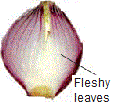Leaf in plant
Morphology of leaves deals with the study of the structural features and parts of a leaf.
The leaf is a lateral, generally flattened structure borne on the stem. It develops at the node and bears a bud in its axil. The axillary bud later becomes a branch. Leaves originate from shoot apical meristems and are arranged in an acropetal order. They are the most important vegetative organs for photosynthesis.
Parts of a Leaf

The leaf base, petiole, and lamina are the main parts of a leaf.
Leaf Base
This is the part where a leaf attaches to a stem. Leaf base has two small leaf-like structure called stipules. In plants like paddy, wheat and other monocotyledons(this leaf base is wide and masks the stem).
Petiole
Petiole is the long, thin, stalk which links the leaf blade to the stem.
Lamina
Lamina is known as leaf blade. It is mostly green, flat surface of the leaves. It consists of a small branched vein and veinlets. The vein that runs along the middle of the lamina is called midrib. Midrib divides the surface of the lamina into two. These veins and veinlets give rigidity to the leaf blade and help in the transportation of water and other substances.
Venation
The arrangement of veins and the veinlets in the lamina of leaf is termed as venation.
Reticulate Venation
When the veinlets form a network, the venation is termed as reticulate. Leaves of dicotyledonous plants generally possess reticulate venation. Example is Leaves of rose plant
Parallel Venation
When the veins run parallel to each other within a lamina, the venation is termed as parallel. The parallel venation is the characteristic of most monocotyledons. Example is Leaves of paddy
Types of Leaves
There are two type of leaves which are further classified into different groups based on their shape, size, their arrangements on the stem, leaves of flowering and non-flowering plants, and various other physical attributes.
1. Simple Leaf
In this case, a single lamina is connected to the main stem by a petiole than leaf is said to be simple. A simple leaf may be incised to any depth but not down to the midrib or petiole, example is Guava leaves.
2. Compound Leaf
A compound leaf is a leaf made up of more than one leaflets. In a compound leaf, the midrib of the leaf is branched into different leaflets and is connected by a single petiole, examples are Pea, palm leaves.
These are further sub-divided into the following types:
| Palmately Compound Leaf | Pinnately Compound Leaf |
 |
 |
2.1 Palmately Compound Leaf
In this case, the leaflets are attached at the tip of the petiole and can be differentiated into following:| Unifoliate | The leaves have only one leaflet. | Citrus |
| Bifoliate | The leaves have two leaflets. | Balanites |
| Trifoliate | The leaves have three leaflets emerging from the same point. | Oxalis |
| Quadrifoliate | The leaves have four leaflets arising from the same point. | Marsilea |
| Multifoliate | This type of leaf has many leaflets arising at a common pint. | Bombax |
2.2 Pinnately Compound Leaf
In this case, the midrib of the leaf is divided into numerous leaflets and all connected by a common axis.and these can be further differentiated into following:| Pinnate | A compound leaf that has an axis on each side of the midrib is known as a pinnate leaf. | Example |
| Unipinnate | The leaf with leaflets on each side of the axis. | Cassia |
| Bipinnate | In this case, a secondary axis bearing the leaflet is produced by the central axis. | Acacia |
| Tripinnate | In this case, a tertiary axis bearing leaflets emerges from the secondary axis. | Moringa |
| Decompound | In this case, Leaf with more than three pinnate. | Old leaves of coriander |
| Parapinnate | In this case, A leaf without a terminal leaflet. | Cassia |
| Imparipinnate | In this case, Leaf with an odd terminal leaflet. | Pea |
Phyllotaxy
The leaves arrangement patterns on the stem are called Phyllotaxy. Plants show three types of phyllotaxy as follows:
| Alternate | When only a single leaf develops at each node alternatively, example is China rose. |  |
| Opposite | When a pair of leaves develops at each node opposite to each other, example is Guava plants. |  |
| Whorled | When more than two leaves develop at the nodes to form a whorl of leaves, example is Alstonia. |  |
Modifications of Leaves
Leaves are often modified to perform functions other than photosynthesis.
They are converted into tendrils for climbing as in peas or into spines for defence as in cacti
The fleshy leaves of onion and garlic store food.
In some plants such as Australian acacia, the leavesare small and short-lived. The petioles in these plants expand, become green and synthesise food.
Leaves of certain insectivorous plants such as pitcher plant, venus-fly trap are also modified leaves.
| Peas | Cactus | Onion |
|
|
|



